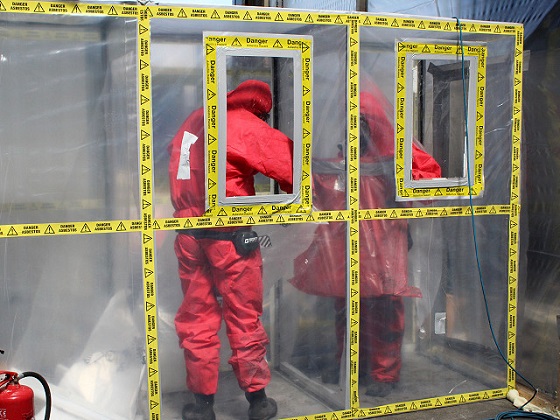Also Interesting
Breaking Down the Cost of Asbestos Removal for Toronto Homes

Asbestos was once widely used in home construction due to its durability and fire resistance, but it is now known to pose serious health risks, including lung disease and cancer. For Toronto homeowners, understanding the asbestos removal cost is crucial for maintaining a safe living environment. This guide explores the main factors impacting asbestos removal expenses and typical costs and why choosing professional asbestos removal in Toronto is essential for effective, safe results.
Why Asbestos Removal is Essential for Toronto Homes
Asbestos fibres are highly toxic when they become airborne, posing a risk to anyone who inhales them. Found in older homes built before the 1980s, asbestos can still exist in many structures across Toronto, especially in insulation, flooring, and roofing materials. When disturbed, these fibres are released into the air, creating a dangerous environment. This is why asbestos removal in Toronto is not just a smart choice but a necessary step for safeguarding your health.
Factors that Influence Asbestos Removal Cost
The asbestos removal cost in Toronto varies significantly depending on a few main factors:
- Size of the Contaminated Area
- Larger areas of asbestos contamination require more labour, materials, and time to remove safely, which can drive up the overall cost. For instance, removing asbestos from an entire basement will generally cost more than handling a single room or small area.
- Type of Asbestos Material
- Different forms of asbestos, like friable and non-friable, are more challenging to remove due to their structural composition. Friable asbestos, which crumbles easily, poses a higher risk of airborne fibres, and its removal often requires extra precautions and, therefore a higher cost.
- Location of Asbestos in the Home
- Asbestos can be present in different parts of a home, from walls and ceilings to floors and HVAC systems. The complexity of removing asbestos from certain areas, such as ductwork, can increase the asbestos removal cost.
- Condition of the Asbestos Material
- If asbestos material is already damaged, the removal process becomes more delicate and complex. Damaged asbestos poses a higher risk of releasing fibers, requiring specialized removal techniques, containment, and disposal, which add to the cost.
Typical Price Range for Asbestos Removal in Toronto
Generally, asbestos removal in Toronto can range from $1,000 for small, contained areas to $10,000 or more for extensive contamination. For a single room, homeowners might expect to pay between $2,000 and $4,000. However, larger projects, such as removing asbestos from multiple areas in an older home, can easily exceed this range.
Each home is different, so it’s best to have a professional assess the specific asbestos removal cost for your property. A trained inspector can give you a precise estimate based on the scope of work needed.
Additional Costs to Consider in Asbestos Removal
Several additional expenses can contribute to the asbestos removal cost, including:
- Inspection and Testing Fees
- Before removal, testing is essential to confirm the presence and type of asbestos. The cost of asbestos testing can range from $200 to $600, depending on the number of samples needed.
- Permits and Disposal Fees
- Disposal of asbestos requires compliance with strict regulations. The cost of securing permits and handling hazardous material disposal can add to the total expense, often between $500 and $1,000.
- Restoration Costs
- After asbestos removal, homeowners may need to repair or replace materials like drywall, flooring, or ceiling tiles. The cost of restoration can vary widely but should be considered when budgeting for asbestos removal in Toronto.
Choosing a Professional Asbestos Removal Service in Toronto
Selecting a reliable asbestos removal service is essential to ensure the job is done safely and effectively. When choosing a professional for asbestos removal in Toronto, consider companies with proper certifications, insurance, and positive customer reviews. Here are a few tips:
- Look for Licensed Professionals
- Make sure the company has the necessary certifications to handle asbestos. This will ensure they adhere to industry standards and best practices.
- Request Detailed Estimates
- A reputable company will provide a detailed estimate that outlines all costs, including inspection, removal, and disposal. This helps avoid unexpected fees.
- Check Customer Reviews
- Customer feedback can give you insight into the company’s reliability, professionalism, and overall quality of service.
Hiring an experienced asbestos removal company not only ensures a safer process but can also help prevent unnecessary expenses down the line.
Cost-Saving Tips for Asbestos Removal in Toronto
To help reduce the asbestos removal cost, consider these practical tips:
- Compare Quotes
- Getting quotes from several asbestos removal companies in Toronto allows you to compare prices and choose the best option.
- Combine Projects
- If you’re planning renovations or other home repairs, try to schedule asbestos removal simultaneously. This can save on labour and setup costs.
- Prepare the Area
- Clearing furniture or preparing the space before professionals arrive can help reduce setup time, potentially lowering your overall expenses.
Asbestos Removal for Toronto Residents
Understanding the factors influencing asbestos removal costs can help Toronto homeowners make informed decisions about this critical service. With Toronto’s older housing stock, it’s crucial to address asbestos issues promptly and safely. By hiring professionals for asbestos removal in Toronto, homeowners can ensure a safer, healthier living environment for their families.
Also Interesting
Keeping Strategic Partnerships On Track with Data Rooms

Strategic partnerships move fast, then stall for familiar reasons: scattered contracts, unclear change control, misaligned KPIs, and painful renewals. A modern virtual data room solves those execution gaps by giving both parties a single, secure workspace to negotiate and govern the relationship.
Below is a practical playbook for partnership for legal and governance teams that need better oversight of the process without slowing the deal.
Why partnerships fail in execution
Alliances now account for a rising share of growth activity, yet many underperform because governance and information flows break down after the signing ceremony. McKinsey has reported sustained growth in partnership activity and the need for rigor in how companies structure and manage complex partner portfolios.
Risk compounds as third parties plug deeper into your tech stack and customer data. KPMG’s recent third-party risk work highlights regulatory pressure and real breach exposure tied to vendor access — amplifying the need for disciplined data, access, and contract controls across the partner lifecycle.
What a VDR contributes that shared drives can’t
Virtual data room services outperform generic cloud folders in four partnership jobs-to-be-done:
- A secure contract repository that centralizes master agreements, statements of work, schedules, and side letters, with version history and tamper-evident audit trails. This is foundational for obligations management and dispute resolution. Research shows that advanced contract lifecycle controls materially reduce missed obligations and improve risk visualization.
- Permissioned partner access so each party sees only what they must. Granular, role-based permissions and watermarking help you share sensitive materials with confidence during escalations or executive reviews. HBR’s long-standing guidance on alliance scorecards underscores the value of clear information rights and accountability, which VDRs operationalize day to day.
- Milestone tracking in VDR to link documents and discussions directly to the KPIs that define success — launch dates, enablement targets, marketing funds, or co-sell quotas — so status never lives in email threads.
- Renewal and compliance files managed in one place for audits, certifications, cybersecurity questionnaires, privacy addenda, and regulatory notices. With regulators sharpening expectations on third-party oversight, having these artifacts organized and provable is no longer optional.
Selecting data room providers for partnerships
In the process of selecting data room providers, you should evaluate top vendors against your partnership-specific needs, not just M&A checklists. Here’s what to pay attention to:
- Granular permissions that support external groups and expiring links.
- Tasking and approvals to shepherd redlines, consent requests, and change orders.
- API and SSO so you can sync with CRM and other tools.
- Audit-quality logs and data residency options for regulated markets.
- Structured dashboards for milestone tracking in VDR without exporting to slides.
If you’re comparing options, check out data room provider reviews at dataroom.org.uk page — a curated platform that evaluates the VDR providers. You’ll find it useful if you want your partnerships to run for years rather than weeks.
Designing the core folder architecture
Once you have a decent data room selected, you’re ready to think about folder architecture. Experienced teams use a common structure across deals so stakeholders can find the right file in seconds. A typical data room for partnerships includes:
- Governance — charters, joint steering deck, RACI, escalation paths, meeting minutes.
- Contracts — MSA, SOWs, pricing exhibits, data protection terms, change orders.
- Delivery — technical specs, APIs, integration test evidence, rollout plans.
- Commercials — business cases, rebate logic, MDF claims, sales playbooks.
- Compliance & risk — SOC/ISO reports, penetration tests, DPIAs, DPA annexes.
- Performance & KPIs — dashboards, QBR packs, remediation logs.
- Renewal & amendments — redlines, approvals, countersigned documents.
Keep naming conventions strict (e.g., YYYY-MM-DD_DocumentName_Vx), and map folders to contract clauses so audits are traceable to obligations.
Access control that matches real-world roles
Partnerships span legal, finance, security, product, marketing, and sales on both sides. Use the VDR’s permission model to mirror this:
- Internal core team: full read/write within governance, contracts, and delivery.
- Partner core team: scoped access to execution materials, not internal approvals.
- Executives and board: read-only to governance and KPI packs for QBRs.
- Specialists (security, privacy, tax): time-boxed, watermark-protected access to specific subfolders.
This permissioned access keeps collaboration fluid while containing risk if membership changes mid-stream.
From diligence to day 2: Workflows that prevent drift
VDRs shine when you operationalize a few high-leverage workflows:
- Vendor due diligence. Host questionnaires, evidence, and remediation in one trackable space. Thomson Reuters outlines the scope of effective vendor due diligence; your VDR should reflect that scope with structured folders, checklists, and deadlines.
- Security events. Keep incident notifications, joint response notes, and root-cause analyses in the compliance area with restricted access.
- Quarterly business reviews. Publish dashboards, opportunity lists, pipeline hygiene notes, and joint marketing calendars under a single Quarterly Business Review (QBR) folder — reducing prep time and increasing continuity across sponsors.
Contract intelligence that keeps money on the table
Money usually leaks in quiet ways: someone forgets to pay a rebate, prices don’t get updated, or a service promise keeps auto-renewing without anyone checking it. To stop that, you write down the most important details from each deal — like when it renews, how prices can change, what refunds are owed if something breaks, and when special rights end — and you keep those in one safe place everyone can see.
Then you set five important reminders in that same place:
- When the deal is about to renew
- When it’s time to review prices
- When you need to check rebates after each quarter
- When you need to make sure a broken promise got a credit
- When “only we’re allowed to do this” ends
Each reminder should have one person in charge, a due date, and proof saved before anyone can say it’s done.
How to launch a partner VDR in 30 days
You don’t need a massive program to see value. In four weeks, you can stand up a partner-ready data room that legal, security, and sales will actually use:
Week 1 — Foundation. Confirm the folder taxonomy, map documents to contract clauses, and assign owners. Set baseline permissions and watermark settings.
Week 2 — Migration. Move authoritative versions only; archive duplicates. Create a secure contract repository and lock naming conventions.
Week 3 — Workflows. Configure diligence and change-control checklists, SLA tracking, and QBR templates. Enable alerts for renewals and audits.
Week 4 — Operate. Run a QBR using VDR dashboards, test guest invites with permissioned partner access, and review logs. Document playbooks for handoffs if needed.
Partnership pilot programs are forgiving; scale is not. As your partnership expands, decision rights blur, metrics drift, and files scatter. Your VDR should prevent that: one place for obligations, KPIs, and audits, all tied to owners and dates.
Don’t wait for a customer review or regulator to force the issue. Stand up the folder model, set renewal and control alerts, and use QBRs from the data room — not slides.
Also Interesting
4 Digital Trends Local Communities Are Embracing Today

It is no secret that life has become a lot more digital in recent times, particularly since the COVID-19 pandemic. People now do many activities online that they once did in person, which can provide a new level of convenience and accessibility for local communities. It has been fascinating to observe how these digital trends have reshaped modern life as we know it and given people the possibility to easily stay connected and entertained from home or on the move on a mobile device.
With this in mind, this post will explore a few of the biggest digital trends that local communities are embracing today.
1. Virtual Learning
One of the most notable trends that continues to grow each year is virtual learning. These days, people do not have to attend in-person courses and classes to earn qualifications or learn new skills, as they can engage in online learning. This can change people’s lives with the ability to advance their careers, start new careers, or simply expand their horizons without having to leave the house.
2. Online Shopping
Few things have changed life so much in the 21st century as the rise of ecommerce. It is hard to remember a time before when you could not get all of your shopping delivered to your home, offering greater convenience as well as the ability to shop from sellers all around the world. Since the pandemic, local communities are buying practically all of their needs online, including groceries, fashion, furniture, homeware, technology, and much more. Additionally, second-hand marketplaces have surged in popularity in recent times, allowing people to save money and find rare items.
3. Live Casino Games
Many local communities have turned to online casino games in recent times. This can provide the same thrill and excitement of going to a land-based casino with the convenience of playing from home or on the move. In recent years, online live casino games have taken off. These are games with a real-life dealer using streaming technology, helping to create a more realistic, engaging, and social experience. This includes live blackjack, roulette, and baccarat at popular online casinos where you can interact with dealers and other players via a live chat function. Casino games are often seen as a solo activity, but this is changing with the rise of live casino games.
4. Virtual Fitness
The way in which people exercise and stay in shape is also changing. Now, virtual PT sessions and exercise classes give people the ability to exercise and socialize without having to leave the house. This is ideal for those who crave social connection as part of their exercise regime but have busy schedules and/or live in remote areas. This has also extended to wellness in recent times with guided meditation sessions and virtual yoga classes, allowing people to look after their overall well-being from home.
These are a few of the main digital trends that have emerged in recent times and changed the way in which local communities lead their daily lives. It will be fascinating to see how these trends evolve and what new trends emerge in the years to come as life becomes increasingly digital.
-

 Great Reset2 days ago
Great Reset2 days agoViral TikTok video shows 7-year-old cuddling great-grandfather before he’s euthanized
-

 Daily Caller2 days ago
Daily Caller2 days agoChinese Billionaire Tried To Build US-Born Baby Empire As Overseas Elites Turn To American Surrogates
-

 Alberta2 days ago
Alberta2 days agoSchools should go back to basics to mitigate effects of AI
-

 International2 days ago
International2 days agoAt Least 15 Killed In Shooting Targeting Jewish Community At Australia’s Bondi Beach, Police Say
-

 International2 days ago
International2 days agoTwo states designate Muslim group as terrorist
-

 Business2 days ago
Business2 days agoMajor tax changes in 2026: Report
-

 Digital ID1 day ago
Digital ID1 day agoCanada releases new digital ID app for personal documents despite privacy concerns
-

 Bruce Dowbiggin1 day ago
Bruce Dowbiggin1 day agoNFL Ice Bowls Turn Down The Thermostat on Climate Change Hysteria






